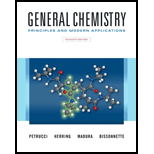
Concept explainers
(a)
Interpretation:
The
Concept introduction:
Hybridization is a hypothetical phenomenon where atomic orbitals combine to form new hybrid orbitals takes place.
In the chemical bonding, an antibonding molecular orbital is a type of molecular orbital which is to weaken the chemical bond present between two atoms and therefore the energy of the molecules increases.On the other hand, bonding molecular orbitals are the kind of orbitals which contain electrons that are present between the nuclei and hence they stabilize the molecule.
(b)
Interpretation:
The chemical bonding in the given molecule is to be represented with the help of a sketch.
Concept introduction:
Hybridization is a hypothetical phenomenon where atomic orbitals combine to form new hybrid orbitals takes place.
In the chemical bonding, an antibonding molecular orbital is a type of molecular orbital which is to weaken the chemical bond present between two atoms and therefore the energy of the molecules increases.On the other hand, bonding molecular orbitals are the kind of orbitals which contain electrons that are present between the nuclei and hence they stabilize the molecule.
(c)
Interpretation:
The chemical bonding in the given molecule is to be represented with the help of a sketch.
Concept introduction:
Hybridization is a hypothetical phenomenon where atomic orbitals combine to form new hybrid orbitals takes place.
In the chemical bonding, an antibonding molecular orbital is a type of molecular orbital which is to weaken the chemical bond present between two atoms and therefore the energy of the molecules increases.On the other hand, bonding molecular orbitals are the kind of orbitals which contain electrons that are present between the nuclei and hence they stabilize the molecule.
Want to see the full answer?
Check out a sample textbook solution
Chapter 26 Solutions
GENERAL CHEMISTRY-MOD.MASTERINGCHEM.
- H I T H HH H -H C. H- Identify and select all structures below that represent a constitutional isomer(s) of the compound shown above. H- H CIH H H H HHHH H H 0 ·H H– 冊 CH CHI HH C- H- H H- H H A. H H C H H- -H HH H B. H- -H D. H H H H • H -H E. -H H H HICH T HHH F. H-arrow_forwardPolylactic acid (shown below) is a biodegradable polymer used for food packaging. Identify the monomer(s) used in the production of this polymer using a condensation process.arrow_forwardDraw the product of the reaction shown below. Ignore small byproducts that would evaporate pleasearrow_forward
- Poly(ethylene adipate) is a biodegradable polyester (shown below). Identify the type of polymerization process used in the production of this polymer.arrow_forwardPolymers may be composed of thousands of monomers. draw two repeat units(dimer) of the polymer formed in this reaction. assume there are hydrogen atoms on the two ends of the dimer. ignore inorganic byproducts pleasearrow_forwardDraw the product of the reaction shown below. Use a dash or wedge bond to indicate stereochemistry of substituents on asymmetric centers, Ignore inorganic byproductsarrow_forward
- Draw the product of this reaction please. Ignore inorganic byproductsarrow_forwardOne of the pi molecular orbitals of 1,3-butadiene (CH2=CHCH=CH2) is shown below. Please identify the number of nodal planes perpendicular to the bonding axisarrow_forwardDraw the monomers required to synthesize this condensation polymer please.arrow_forward
- Provide the correct systematic name for the compound shown here. Please take into account the keyboard options belowarrow_forwardcurved arrows are used to illustrate the flow of electrons. using the provided starting and product structures, draw the curved electron-pushing arrows for the following reaction or mechanistic step(s)arrow_forwardIdentify the 'cartoon' drawing of the acceptor orbital in the first mechanistic step of an electrophilic addition reaction of butadiene with HBr. Pleasearrow_forward
 Organic Chemistry: A Guided InquiryChemistryISBN:9780618974122Author:Andrei StraumanisPublisher:Cengage LearningChemistry: Matter and ChangeChemistryISBN:9780078746376Author:Dinah Zike, Laurel Dingrando, Nicholas Hainen, Cheryl WistromPublisher:Glencoe/McGraw-Hill School Pub Co
Organic Chemistry: A Guided InquiryChemistryISBN:9780618974122Author:Andrei StraumanisPublisher:Cengage LearningChemistry: Matter and ChangeChemistryISBN:9780078746376Author:Dinah Zike, Laurel Dingrando, Nicholas Hainen, Cheryl WistromPublisher:Glencoe/McGraw-Hill School Pub Co Principles of Modern ChemistryChemistryISBN:9781305079113Author:David W. Oxtoby, H. Pat Gillis, Laurie J. ButlerPublisher:Cengage Learning
Principles of Modern ChemistryChemistryISBN:9781305079113Author:David W. Oxtoby, H. Pat Gillis, Laurie J. ButlerPublisher:Cengage Learning



